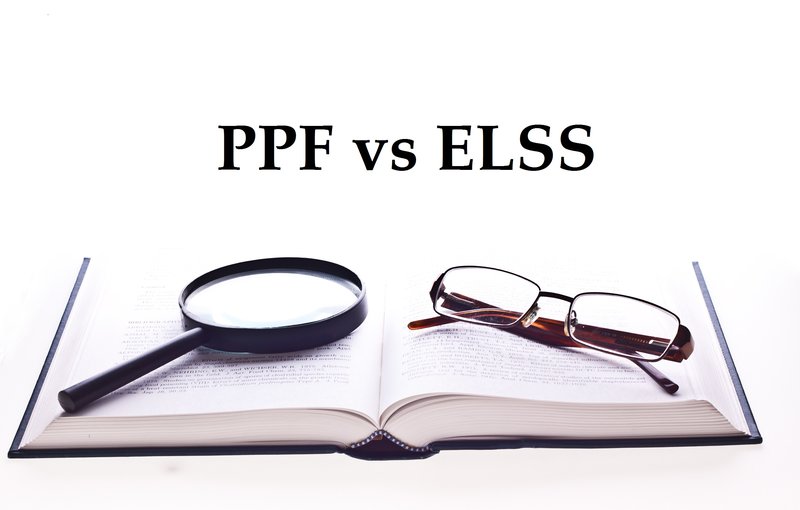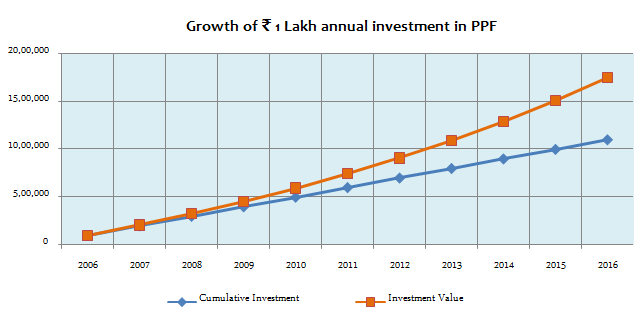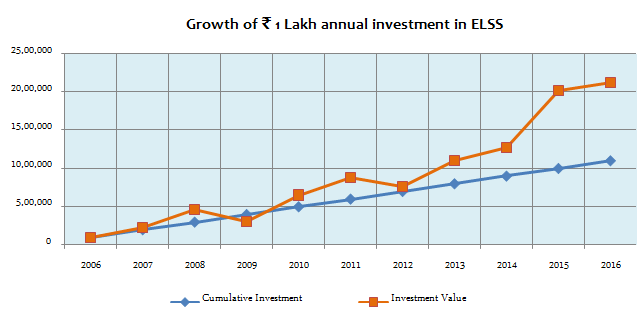Did you know ELSS Mutual funds are better option than PPF

In our post, What are the Best Tax Saving Investments: Fixed Income Part 1, we had discussed that, Public Provident Fund (PPF) is one of the most tax friendly risk free investment option under Section 80C of Income Tax Act 1961. From a tax standpoint, PPF is exempt at the time of investment (tax savings under 80C), exempt from tax during the tenure of the investment and exempt from tax upon maturity (exempt – exempt – exempt). Though PPF interest rate has come down considerably over the past year, it is still one of the best long term investment options for risk-averse investors.
In the previous post, we had also discussed that, Equity Linked Savings Scheme (ELSS), a market linked investment option, also qualifies for tax savings under Section 80C of Income Tax Act 1961 (up to a limit of र 1.50 Lakhs per annum). From a tax standpoint, ELSS, like PPF, is exempt at the time of investment (tax savings under 80C), exempt from tax during the tenure of the investment and exempt from tax upon maturity (exempt – exempt – exempt). Unlike PPF, ELSS is subject to market risks, but also has the potential to give higher returns. In this post, we will compare wealth created by PPF and ELSS over the past 10 years (2006 to 2016).
Wealth creation by PPF
Let us assume, you invested र 1 Lakh per annum in PPF from 2006 onwards. For the sake of simplicity, let us assume, you made your deposit on January 1 every year; the last deposit was made on January 1, 2016. The chart below shows the growth of your PPF account balance from 2006 to 2016. If you want to see PPF returns for any period (compared to ELSS), please use our research tool, PPF vs ELSS. Using our tool, you can see the difference between PPF and ELSS (any mutual fund tax saver scheme), for any investment amount, investment frequency (monthly, quarterly, yearly etc) and any investment period.

Source: Advisorkhoj Research
Your PPF account balance on January 1, 2016 would be र 17.5 Lakhs, while your cumulative deposit over the 10 year period would have been र 11 Lakhs. Therefore, cumulative interest earned by you over the last 10 years was र 6.5 Lakhs. This interest is totally tax free. Let us now discuss how much wealth you would have created by investing the same amount in ELSS every year.
Wealth creation by ELSS
Let us assume you invested र 1 Lakh per annum in an ELSS fund from 2006 onwards. For the sake of simplicity, let us assume, you made your investment on January 1 every year; the last deposit was made on January 1, 2016. There are a number of Equity Linked Savings Schemes in the market; different schemes have given different returns in different years. The purpose of this post is not to tell you, which was the best performing ELSS fund in the last 10 years because it is not relevant; the best performing fund in the last 10 years may not be the best performing fund in the next 10 years.
In this post, we are discussing the wealth creation potential of equity as an asset class, relative to a risk free investment like PPF. Hence in this example, we have assumed the return of your ELSS fund was the average ELSS category returns over the last 10 year (2006 to 2016) period. The chart below shows the growth of your annual ELSS investment from 2006 to 2016.

Source: Morningstar
Compare this chart with the previous (PPF) chart. You can see in the previous (PPF) chart that growth of your investment was almost linear, but in this chart the growth is much more volatile. Recall, earlier in our post, we said that, ELSS is subject to market risks. Your ELSS investment value would have fallen below your cumulative investment in late 2008 / early 2009. But let us look at wealth creation over the 10 year horizon. Your ELSS investment value on January 1, 2016 would be र 21.3 Lakhs, while your cumulative investments over the 10 year period would have been र 11 Lakhs. The wealth creation by ELSS was nearly र 4 Lakhs more than that of PPF.
You should know that, a long (e.g. 10 year) investment horizon will have both bull and bear markets. Your investment value will rise in bull markets and fall in bear markets. From 2006 to 2016, we had three bear markets – 2008, 2011 and 2015/2016. But over the same 10 year period, we also had bull market years. The fall in bear market was more than compensated by the rise in bull markets. That is why we say, equity is the best performing asset class over a sufficiently long investment horizon.
Liquidity
Most Section 80C eligible investments have a minimum tenure of at least 3 years. Therefore, when you are making a tax saving investment, you have a long term investment horizon. The tenure of PPF is 15 years. ELSS funds have a lock-in period of 3 years. If you are investing in ELSS through SIP, each instalment is locked in for 3 years. Purely from a liquidity perspective, ELSS is one of the most liquid 80C investment options. This is not to suggest that, you should redeem ELSS investment after 3 years, because the longer you remain invested, the more you stand to gain through the power of compounding. The liquidity of ELSS compared to other 80C investment options is just an added advantage, should you for any emergency purpose need the funds.
Other Benefits
As discussed earlier, Equity Linked Savings Scheme (ELSS) is also one of the most tax efficient 80C investment options. Mutual funds are also very flexible investments. If you want income from your ELSS investment, you can invest in the dividend option of ELSS funds. However, you should understand that, mutual fund dividends are paid out of the profit of the funds and since mutual fund profits are market linked, dividend amount or the pay-out date is not assured. ELSS through Systematic Investment Plan (SIP) offers flexibility of a variety of investment frequencies, e.g. monthly, quarterly, annual etc.
We in Advisorkhoj are advocates of systematic investing, because it can help you stay disciplined in your financial planning and also help you take advantage of equity volatility through rupee cost averaging. ELSS also offers withdrawal flexibility, either in lump sum or systematically through Systematic Withdrawal Plan (SWP).
Conclusion
Even though investors make Section 80C investments to get tax deductions from their gross taxable income, tax savings, by itself, should not be the only objective. In Advisorkhoj, we think that, every investment decision should be goal based. As such, investments made under Section 80C, should also have specific financial objectives, based on your personal needs. When making any investment, you should also think about optimal asset allocation. Equity Linked Savings Scheme (ELSS) investments can provide solutions to long term investment objectives like retirement planning, children’s education / marriage etc. You should discuss with your financial advisor, if ELSS is suitable for your tax planning investments.
Mutual Fund Investments are subject to market risk, read all scheme related documents carefully.
RECOMMENDED READS
Sundaram Asset Management Company is the investment manager to Sundaram Mutual Fund. Founded 1996, Sundaram Mutual is a fully owned subsidiary of one of India's oldest NBFCs - Sundaram Finance Limited.
Quick Links
- Interview - Mr. Dwijendra Srivastava - CIO - Fixed Income
- Interview - Mr. Sunil Subramaniam - CEO
- Sundaram Select Midcap Fund: Consistent outperformance makes it a big wealth creator
- Interview - Mr. Sunil Subramaniam - CEO
- Fund Manager Interview - Mr. Krishna Kumar - CIO - Equities
- Sundaram Rural India Fund: This thematic Mutual Fund aiming good long term returns
- Sundaram Equity Multiplier: Long term wealth creation potential
- Our Articles
- Our Website
- SIP one sheeter-Investor Education initiative
- Sundaram Asset Management Singapore
- Returns Calculator
- SEBI Investor Awareness Initiative
- Check your KYC Status
- KYC Forms & FAQs
- Recieve your PIN
- A note on NIGO
- FAQs on RGESS
- FAQs on Direct Plan
- Receive Updates
- Share your views
- Transmission Checklist
- Equity Application Form
- Fixed Income Application Form
- Transaction Slip
- Factsheet May - 2016
- MF Tax Reckoner 2015
Follow Sundaram MF
More About Sundaram MF
POST A QUERY




